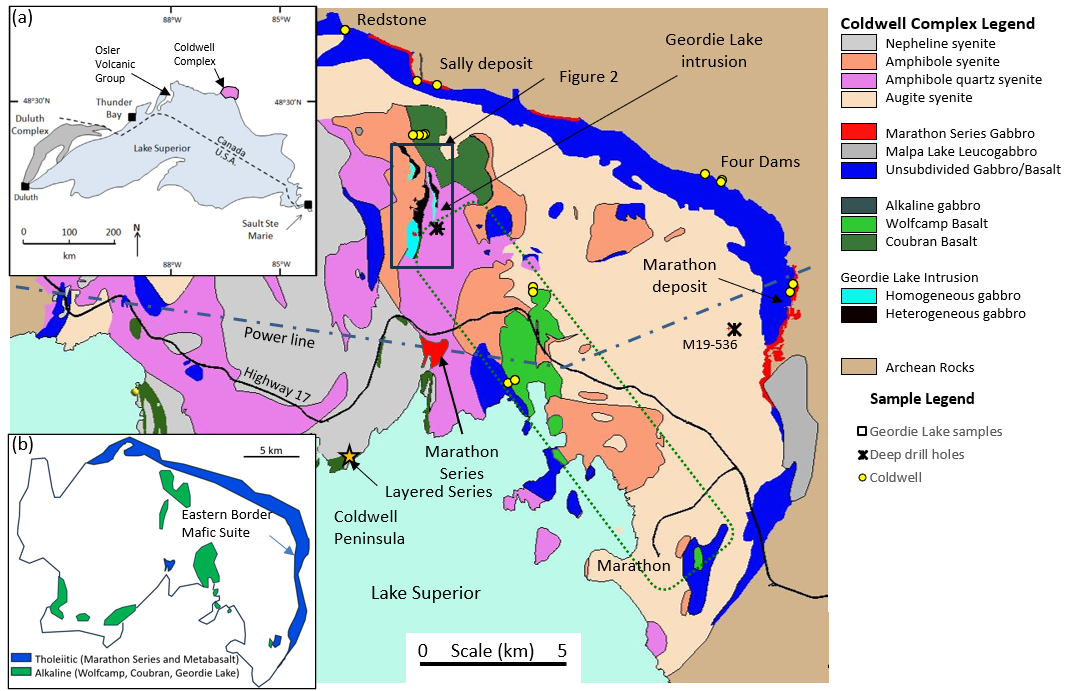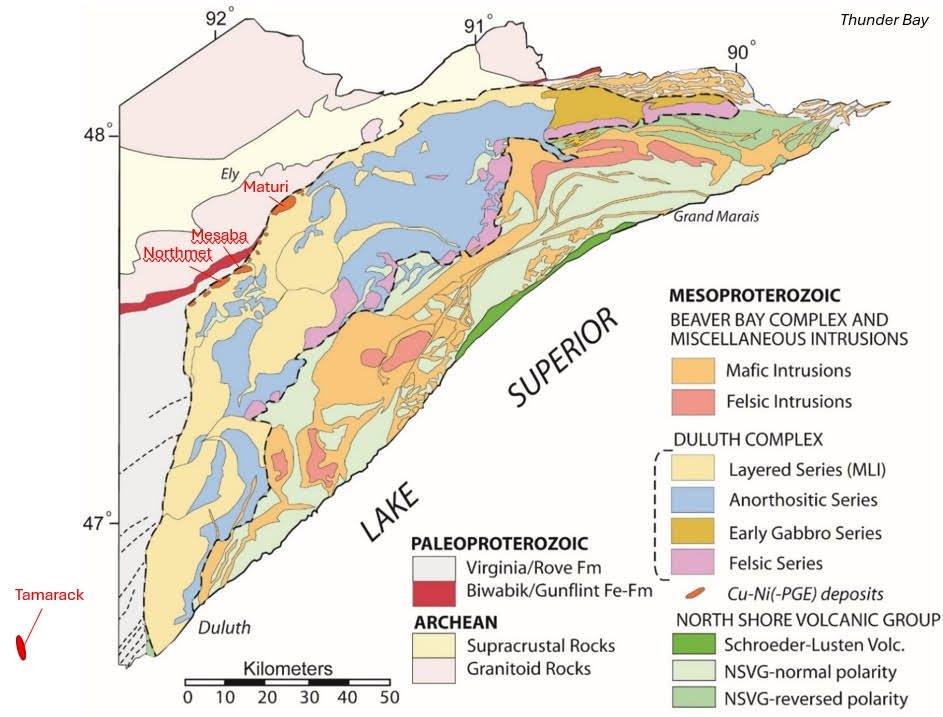Field Trips
Trip 1 (pre meeting)
Title: Geology of the Lac des Iles Palladium mine
Dates: Monday August 5th, 2024
Trip Leaders: Lionnel Djon and Lac des Iles geology team
The field trip at the Lac des Iles Palladium Mine promises an engaging exploration of key geological features. The journey will commence with a scenic viewpoint overlooking the Roby and Sheriff pits. Participants will delve into discussions regarding the spatial relationship between the high-grade hanging-wall schist and the lower grade footwall breccia rocks which taken together form the >10 M Oz Roby-Offset-Camp Lake deposit. Noteworthy satellite ore zones, including Sheriff, Powerline, Roby NW, and Roby SW, will also be reviewed.
Continuing north of the Roby Pit, the tour will visit the North VT Rim outcrop exposure. Participants will assess vari-textured norite and bonanza-grade Pd mineralization, gaining valuable insights into the metal distribution and zonation at Lac des Iles. The journey will progress northeast to Creek Zone, offering a firsthand look at the stratigraphy of the Mine Block Intrusion in recently exposed trenches. This area features vari-textured and brecciated units to the north, mineralized norite to the south, and magnetite gabbro near the intrusion core. Additionally, ultramafic rocks from the adjacent North Lac des Iles complex, such as websterite and clinopyroxenite, can be observed at Creek Zone.
Concluding the field trip, participants will explore the discovery outcrop at Baker Zone, located approximately 1 km northeast of the Roby Pit. Here, a diverse array of magmatic breccia textures will be on display, alongside Ni-Cu-PGE mineralization linked to fine-grained disseminated chalcopyrite and coarse-grained chalcopyrite-pentlandite-pyrrhotite blebby intergrowths. The interpreted vertical breccia pipe structure comprises leucocratic vari- textured norite and hetero-lithic breccia units, forcefully intruding the mela-norite host rocks of the East Mine Block area. The observations at Baker Zone hold significant implications for understanding the relative timing of magmatic breccia formation.
Upon returning from the field, Impala Canada geologists will guide a comprehensive review of selected drill core in the core logging facility, providing participants with further insights into the geological complexities encountered during exploration.
Trip 2 (pre meeting)
Title: Cu-PGE deposits of the Coldwell Complex (Caldera), Ontario
Dates: Sunday August 4th to Monday August 5th, 2024
Trip Leader: Dave Good and Al MacTavish
This two-day field trip will feature three unique Cu-PGE deposits in the context of a caldera structure in the Proterozoic Coldwell Complex on the northeast shoulder of the Midcontinent Rift.
The first day will be spent on outcrops examining the four major rock series associated with pre-, syn- and post caldera formation and late brecciation during syenite intrusion.
The second day will be spent visiting outcrops at the Marathon deposit and examining drill core for the Geordie Lake and Four Dams Cu-Pd deposits. Mineralization types include:
- pyrrhotite- to bornite-rich assemblages and extreme PGE enrichment at the Marathon deposit (tholeiitic),
- bornite-chalcopyrite assemblage associated with skeletal olivine in troctolite breccia at the Geordie Lake deposit (alkaline), and
- chalcopyrite-pyrrhotite assemblage within apatite-olivine-clinopyroxene cumulate rocks at the Four Dams occurrence.

Trip 3 (post meeting)
Title: Mesoproterozoic Ni-Cu Deposits of Northeastern Minnesota
Dates: Friday, August 9th – Monday, August 12th, 2024
Trip Leaders: Jim Miller, University of Minnesota Duluth (retired); Mark Severson, Natural Resources Research Institute, UMD (retired); Brian Goldner, Talon Nickel; Sam Weatherley, New Range Cu-Ni; Kevin Boerst, Twin Metals
This four-day field trip will highlight the geologic setting and mineralization styles of two major occurrences of Ni-Cu-PGE sulfide deposits associated with the 1.1 Ga Midcontinent Rift exposed in northeastern Minnesota. A full day will be devoted to examining drill core from several deposits exposed along the basal intrusive contact of the massive, gabbroic Duluth Complex. These will include New Range Cu-Ni's Northmet and Mesaba deposits and Twin Metal’s Maturi deposit. The following day will focus on viewing mineralized drill core from Talon Nickel's Tamarack deposit, which is hosted by an ultramafic chonolithic intrusion emplaced into Paleoproterozoic metasediments. Additional field stops will visit classic outcrops of Midcontinent Rift geology exposed along the North Shore of Lake Superior and a half-day excursion through type locality of the Duluth Complex at Duluth.

Trip 4 (post meeting)
Title: Geology and mineral deposits along the southern margin of the Midcontinent Rift
Dates: August 11th - 15th
Trip Leaders: Dean Rossell (Talon Metals) and Bob Mahin
The bulk of historic metallic mineral production directly related to the ~1.1Ga Midcontinent Rift (MCR) large igneous province has come from mineral deposits located along the southern margin of the Rift. The diverse deposit types range from the famous Keweenaw basalt and interflow sediment hosted native copper deposits , which were mined by aboriginals for
thousands of years prior to the arrival of Europeans, to the Eagle magmatic Ni-Cu mine, the only currently producing, primary nickel mine in the USA.
This four day field trip, which will start and end in Duluth, Minnesota, will be focused on examinations of outcroppings and drill core of the volcanics, sediments and intrusions located along the south margin of the MCR. The trip will include visits to a well exposed section of the host rocks to “White Pine type” Cu-Ag deposits hosted within the Rift fill sediments; a visit to the A. E Seaman mineral museum in Houghton, MI with its spectacular displays of the finest mineral specimens from the Keweenaw native Cu deposits; and drill core and outcroppings of early MCR, mineralized, mafic/ultramafic intrusion(s) including a core shed tour of the Eagle and Eagle East, high grade, magmatic Ni-Cu deposits. Along the way, we’ll also have a look at some examples of the dykes that make up the Early MCR Baraga dyke swarm, which overlaps in age with the early MCR magmatic sulfide deposits, and the Paleoproterozoic sediments that form the immediate country rock to the intrusions hosting the known MCR related, magmatic sulfide mineralization in Michigan.

